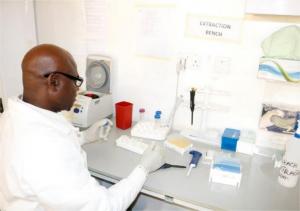WHO supports improved diagnostic capacity to fast-track Lassa fever control
Abuja, 17 July, 2018 - The Nigeria Centre for Disease Control (NCDC) in collaboration with the World Health Organization (WHO) and other partners, have successfully contained the unprecedented Lassa fever outbreak that claimed the lives of 115 Nigerians (as at 07 July, 2018).
The feat is the result of combined interventions, especially the strengthening of specialised laboratories and isolation centres within health facilities. These efforts culminated into improved diagnostic capacities and patient outcomes, including better response to treatment.
“The unprecedented Lassa fever outbreak in Nigeria this year taught us a lot of important lessons,” says Dr Chikwe Ihekweazu, Chief Executive Officer of NCDC. “It further highlighted that with strengthened surveillance and diagnostic capabilities, we may continue to record more cases of Lassa fever. However, we have begun building on these lessons to improve our capacity both at the national and State levels. In addition to these, we are working with WHO to dedicate more resources to better understand the disease. We have developed a national research plan that will guide activities over the next few years, especially the diagnosis and management of the disease”, he adds.
With support from WHO, and other partners, Nigeria now has four laboratories with the capacity to test for Lassa fever virus. These facilities have undergone significant renovation, staff have been trained and the country has begun the process of ensuring that a harmonised national testing algorithm is in place. Most recently, NCDC introduced a transportation system that ensures samples are promptly conveyed from affected States to testing laboratories.
Continued support for early detection and disease management
For the 2018 outbreak, WHO in collaboration with the NCDC, distributed over 7,000 sets of personal protective kits, to health workers in Lassa fever endemic States. In addition, gaps have been identified and being addressed in prioritized laboratories.
“This year alone, WHO and NCDC provided diagnostic kits, medical reagents, personal protective equipment and they repaired the solar panel systems in our laboratories and isolation wards. This has particularly helped to ensure we have constant power at the facility,” says Dr Ephraim Ogbaini of the Irrua Specialist Teaching Hospitals (ISTH).
The ISTH in the central area of Edo state, Nigeria had particularly struggled with the challenge of curtailing Lassa fever virus for several years.
The Federal Teaching Hospital Abakiliki (FETHA), Ebonyi state has also been another major beneficiary of the Federal Government (FG) led interventions during the Lassa fever crises. “In 2016, the Lassa fever case fatality rate rose to about 60% at the peak of the epidemic. This stirred the FG and NCDC into action as they mobilised resources and technical assistance from WHO. The result of these efforts improved patient outcomes and reduction in the case fatality rate in 2018 to about 17.5% in FETHA,” says Dr Uche Unigwe of FETHA.
According to him, “The establishment of a dedicated isolation and diagnostic facility has improved Lassa fever case detection, disease management and survival rate tremendously.”
Unrelenting commitment
Presently, WHO is committed to providing support to various laboratories and diagnostic centres across Nigeria to improve surveillance and timely diagnosis of all priority diseases including Lassa fever. Over the next few months, intensified work will ensure that the national Lassa fever testing laboratories are equipped and ready for the upcoming epidemic season.
“The WHO will continue to work with NCDC to provide technical support to laboratories and diagnostic centres across Nigeria. This will help ensure more effective response to outbreaks,” Dhamari Naidoo, of WHO Nigeria said.
Support for 2018 Lassa fever response in Nigeria was made possible with contributions from the WHO Contingency Fund for Emergencies (CFE), the World Bank, European Civil Protection and Humanitarian Aid Operations (ECHO fund), Bernhard Nocht Institute for Tropical Medicine (BNI) and the ISTH.
Kindly follow us on Social Media:



